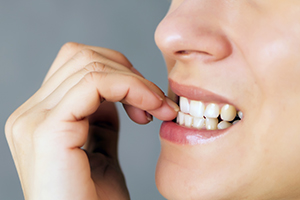 Tooth-related habits, too, can be conscious (brushing and flossing) or unconscious—chewing on pencils, for example. Dental habits become bad when teeth are expected to do things they’re not cut out for—opening bottles, chewing off the little plastic tags on new clothing, trimming nails, and so on. And bad dental habits can be downright dangerous. To name a few:
Tooth-related habits, too, can be conscious (brushing and flossing) or unconscious—chewing on pencils, for example. Dental habits become bad when teeth are expected to do things they’re not cut out for—opening bottles, chewing off the little plastic tags on new clothing, trimming nails, and so on. And bad dental habits can be downright dangerous. To name a few:
Swiss Army Mouth
Mistaking your teeth for a sort of all-purpose bottle-cap-removal-unit-plus-toolbox is a great way of developing unnecessary chips, fractures, and dislocations.
If this is you, resist the urge (and reward yourself with a Swiss Army knife—far less expensive than reconstructing a tooth).
The Ice Crusher
Human teeth and the HMS Titanic have at least one thing in common: neither was designed for impacting large quantities of ice. Besides potentially fracturing tooth enamel, chewing ice can irritate the pulp chamber where the nerve is and reduce the tooth’s resistance to stress.
Leave your ice in the drink where it belongs. Or treat yourself to a Sno-Cone.
Living Hand-to-Mouth
Thumbsucking is the most common habit of infancy. Early on, it’s harmless. But after a while, it can pose dental problems. The compulsive 5- and 6-year-old thumbsucker can change the shape of the roof of his mouth, causing upper teeth to protrude and lower teeth to jut in.
Sometimes a reward for not sucking helps. Or try taking a photograph of your child sucking his thumb. Often—when he sees himself—he wants to quit on his own. The real key here is to help your child stop rather than make him stop.
Mandibular Manicurists
Teeth were no more meant to trim fingernails than they were to open bottles. This is an especially important habit to avoid if you have fragile, reconstructed, or cosmetically enhanced teeth.
Carry a nail file—or sugarless gum, if the habit originates from stress or anxiety.
The Midnight Grinder
Professionally, we call it bruxism—tooth grinding that often goes on while a person sleeps. It’s a common habit (we estimate 20 to 25 percent of the population grinds to some extent) and one that’s hard to control if it happens during sleep.
A dental exam can tell us if you’re a bruxer (typically, we see tell-tale signs of grinding on flat areas where teeth come together). Grinders have found relief in comfortable, custom-fitted acrylic nightguards—along with daily exercise or biofeedback.
But just as important is learning to control the emotional stress—actual or anticipated—that may be bringing it about. Advice for bruxers—try rest, exercise, meditation or whatever else might help you learn how to better handle the daytime tensions that express themselves in nighttime grinding.
The Weedeater
No matter how you take your tobacco (easily, the world’s least beneficial plant), it’s not good for your mouth or teeth. Cigarette, cigar, and pipe smoking increase your risk of gum and oral cancers. You knew that. But even “smokeless” tobacco (snuff and chewing tobacco) does damage.
For one thing, tobacco juice generates a white pre-cancerous growth, leukoplakia, that progresses to oral cancer in more than 5 percent of diagnosed cases. Nicotine also reduces blood flow to gums—diminishing natural resistance to infection while encouraging detachment of gum tissue from the tooth itself.
Sports team dentists advise athletes (and their impressionable young fans) to nix the nicotine habit and instead, take up sugarless gum.
